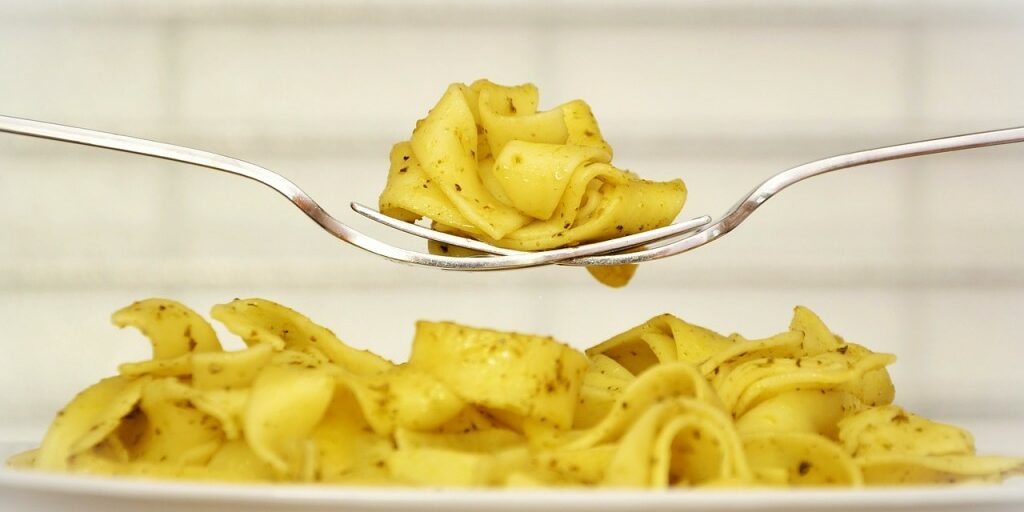Pasta has has such a bad rap over the past few years – it’s been the devil incarnate for dieters and many health-enthusiasts, and yet I’m beginning to realize that pasta isn’t really such a bad thing. A girlfriend admitted to me last week that she (and her voice lowered to an embarrassed whisper,) that she loves nothing more than a bowl of pasta for dinner, and how sad and desperate because she can rarely allow herself this stomach-puffing and cellulite-forming indulgence. But, I explained to my friend that if she knows the facts about pasta, she may be able to enjoy this much-maligned food. It is after all, a big part of the seriously-healthy Mediterranean Diet.
I’ve spent many months in Italy, where gorgeous, slim women regularly enjoy small bowls of pasta for lunch and/or dinner – in fact a pasta course is often part of a dinner. This kind of eating, which is accompanied by lashings of EVOO, basil, Parmesan, and loads of seasonal veggies is actually one of the healthiest ways to eat. I did explain this to my friend, and she lit up – “So, I can really eat pasta and be healthy?” Yes she can, but I did add that she has to be careful about what she slathers on it, because pasta is also a vehicle for ingesting a plethora of healthy veggies, not highly processed/creamy sauces.
The only people who obviously cannot eat pasta are celiacs and/or people who have a severe gluten-intolerance. But, if you find that you are sensitive to the wheat in bread, you probably won’t be bothered in the same way by pasta. Why? Because it’s not the same kind of domesticated “dwarf” wheat —a hybrid high-yield, high-starch, high-gluten wheat—called “dwarf” wheat that was developed in the 1960s as a profit-driven venture to replace traditional wheat varieties in our food supply. Its high amylopectin starch content makes it super- fattening, while it also promotes insulin resistance and diabetes. And, due to the genetic engineering of dwarf wheat that results in extra chromosome sets with more and different gluten proteins than exist in traditional wheat like Einkorn and Emmer, dwarf wheat contains new, untested wheat proteins and in greater numbers that can foster and are linked to wheat allergies and celiac disease.
Pasta is not made from dwarf wheat. It’s actually not even made from the wheat that bread is made from. Pasta is made from Durum wheat, which is very high in gluten and protein, which is why it results in a dense and sturdy dough – perfect for pasta. Barilla is the largest pasta manufacturer in the world. They source 70% of their non-GMO durum wheat from Italy, where it is ground into semolina flour, and then transformed into pasta. The remaining 30% is sourced from North Dakoka (the big duram wheat growing state in the US).So, now we are straight on the difference between wheat used for bread/baked goods, and wheat used for pasta.
Another great thing about pasta is that it has a surprisingly low-glycemic index. A glycemic index is measured on a scale of 1-100. Pasta has a glycemic index of between 43- 61, whereas bread comes in at around 75. The glycemic index relates to how much a certain food will spike your blood sugar. To avoid raising the GI of your pasta, you need to avoid over-cooking it. It should always be al-dente to keep a low-GI index. Overcooking it will make the starches more digestible and thus convert to sugar faster.
Back to the Mediterranean Diet – this is clearly one of the most healthy and anti-aging diets that you can enjoy. And now that we are moving towards summer, we can find beautiful organic tomatoes and basil with which to adorn our healthy bowls of pasta. One of my favorite pasta dishes is a bowl of Barilla Plus (good source of fiber and Omega-3,) topped with sundried tomatoes, Kalamata olives, toasted walnuts, fresh basil, and grated Pecorino cheese. If you are vegan, try topping with my fave Parma Vegan Cheese.
Okay – ladies and gents – here’s the GIVEAWAY part. Leave a comment asking Chef Lorenzo a question: It can be on anything to do with the Mediterranean Diet, recipes, ANYTHING – The top 5 questions will be chosen and I will post the answers next week. ALSO – I will choose one of your questions to win a big box of pasta goodies and an apron from Barilla – so comment away!




